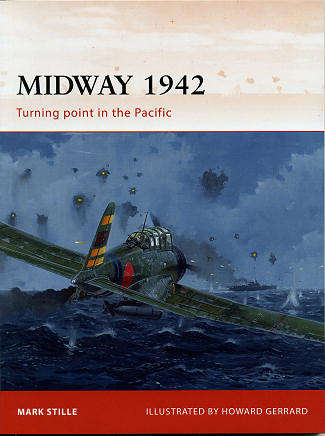 There
are events in warfare that are considered to be turning points in a conflict and
undeniably, the event for WWII in the Pacific was Midway in 1942. It marked the
end of Japanese expansion and provided a rather crippling blow to Japan's
offensive capabilities; specifically to its aircraft carrier force.
There
are events in warfare that are considered to be turning points in a conflict and
undeniably, the event for WWII in the Pacific was Midway in 1942. It marked the
end of Japanese expansion and provided a rather crippling blow to Japan's
offensive capabilities; specifically to its aircraft carrier force.
While this was not immediately apparent, it did put Japan and
the United States on a somewhat even footing in this regard. Previously, Japan
had held an edge and that edge allowed to greater freedom of movement. With the
edge gone, it was more difficult for the Japanese to move forward and in fact,
just the opposite started to slowly happen after Midway as the US invaded
Guadalcanal in the Solomons and began the slow push back.
For the Japanese, Midway was a debacle that shouldn't have
happened. Not only was Midway not really a strategically sound goal, but the
Japanese were overcome with 'victory fever'; feeling that they were invincible.
This led to some very poor judgment calls on the part of the Japanese when parts
of their plan were obviously discovered by US Forces.
The US, on the other hand, was fortunate to have some clear
thinking leadership that allowed them to take advantage of some of the
overconfidence of the Japanese. The Japanese were further hampered
technologically by not having radar aboard their carriers. It prevented them
from having the sort of early warning needed to avoid in-coming US aircraft.
Each time a Japanese ship was attacked, the ship was surprised by the appearance
of US planes, making it too late to take proper evasive action or allow Japanese
air patrols to intercept. This allowed the superiority of American dive bombers
to be able to come into play and destroy Japanese aircraft carriers. On the
other side, the superiority of Japanese torpedo planes allowed the USS Lexington
to be sunk and eventually sink. It is an interesting fact that in 1942, all US
carriers that were torpedoed by the Japanese eventually sank.
In this book on the Midway battle, author Mark Stille
starts with a preamble of events leading up to the battle, a look at the
commanders of both sides and the men under their command. Then there is an
inspection of the plans of both sides. The 'meat' of the volume is next with the
various stages of the battle, including the errors made by both sides and the
fortuitous events that allowed for American victory. Finally,
introspection on how the battle went, what was learned from it, and how it
affected future events. All of
this is superbly illustrated with period photographs and the artwork of Howard Gerrard.
If you want insight into an operation that has had a lot of
press over the last decade or so, or
just a fascinating read, then this is the book for you. I thoroughly enjoyed
reading it and I'm sure you will as well.
October 2010
For more on the complete line of Osprey books,
visit www.ospreypublishing.com. In the US, it is
Osprey Direct at 44-02 23rd St, Suite 219, Long Island City, NY 11101., where you can
get a catalogue of available books.
If you would like your product reviewed fairly and quickly, please contact
me or see other details in the Note to
Contributors.
 There
are events in warfare that are considered to be turning points in a conflict and
undeniably, the event for WWII in the Pacific was Midway in 1942. It marked the
end of Japanese expansion and provided a rather crippling blow to Japan's
offensive capabilities; specifically to its aircraft carrier force.
There
are events in warfare that are considered to be turning points in a conflict and
undeniably, the event for WWII in the Pacific was Midway in 1942. It marked the
end of Japanese expansion and provided a rather crippling blow to Japan's
offensive capabilities; specifically to its aircraft carrier force.